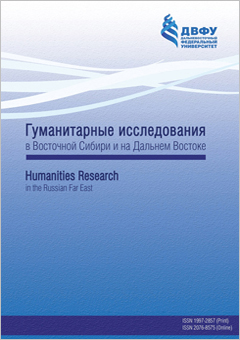К вопросу о наличии письменности у древних айнов
DOI:
https://doi.org/10.24866/1997-2857/2022-2/37-49Ключевые слова:
айны, айнский язык, пиктография, письменностьАннотация
Вопрос наличия письменности у айнов, жителей о. Хоккайдо, а в прошлом – Курильских островов и Сахалина, вот уже два с половиной столетия обсуждается в научных кругах. Айнский язык отнесен к группе бесписьменных языков, а первые записи слов и фольклорных образцов на этом языке были сделаны кириллицей и латиницей. В настоящее время для записи айнских слов используется графическая форма японской слоговой азбуки катакана. Тем не менее, время от времени в журналах и интернете появляются статьи, в которых утверждается, что письменность у древних айнов была. Цель данной статьи – путем анализа имеющихся по этому поводу гипотез, выдвинутых в прошлом, а также обращения к новым данным и научным исследованиям, попытаться представить новый взгляд на рассматриваемую проблему.
Скачивания
Библиографические ссылки
Акулов А.Ю. У айну была письменность // Вестник Сахалинского музея. 2006. № 13. С. 176–182.
Ватасэ Сёдзабуро. Саппоро кинбо: питто сонота косэки но кото (Ямы в районе Саппоро и другие исторические места) // Anthropological Society Report. 1886. Т. 1. № 1. С. 8–10.
Власов Г.М. Итурупские письмена на камнях // Вопросы географии Дальнего Востока. Сборник IV. Хабаровск, 1960. С. 371–374.
Добротворский М.М. Айнско-русский словарь. Казань: Типография Казанского Университета, 1875.
Иванов Вяч.Вс. Об одном типе архаичных знаков искусства и пиктографии // Ранние формы искусства: сборник статей. М.: Искусство, 1972. С. 105–147.
Лаббэ П. Остров Сахалин. Путевые впечатления. М.: Издание М.В. Клюкина, 1904.
Кнорозов Ю.В., Спеваковский А.Б., Таксами Ч.М. Пиктографические надписи айнов // Полевые исследования Института этнографии (1980–1981). М.: Наука, 1984. С. 226–233.
Кнорозов Ю.В., Соболева Е.С., Таксами Ч.М. Пиктографические надписи айнов // Древние системы письма: этническая семиотика. М.: Наука, 1986. С. 268–295.
Кондратенко А.П., Прокофьев М.М. Протописьменность у древних айнов: миф или реальность // Краеведческий бюллетень. 2005. № 2. С. 101–128.
Косарев В.Д. Символ-язык-знак-письмо (в связи с проблемой гипотетической письменности айнов) // Известия Института наследия Бронислава Пилсудского. 2007. № 11. С. 311–351.
Лоукотка Ч. Развитие письма. М.: Иностранная литература, 1950.
Осипова М.В. Минамото-но Ёсицунэ и самураи Мацумаэ: демоны или божества айнов (по материалам айнского фольклора) // Этнографическое обозрение. 2022. № 1. С. 198–212.
Пилсудский Б.О. Знаки собственности айнов // Пилсудский Б.О. Айны Южного Сахалина (1902–1905 гг.). Южно-Сахалинск, 2007. С. 208–239.
Подмаскин В.В. Идеографический характер письма у айнов, палеоазиатов и тунгусо-маньчжуров // Россия и АТР. 2015. № 1. С. 127–145.
Сёдзи Хэйкити. Айно оёби Хоккайдо: но кодаймондзи (Древние знаки Хоккайдо и айнов) // The Journal of the Anthropological Society of Tokyo. 1887. Т. 3. № 20. С. 21–25.
Цубои Сёгоро. Хоккайдо шо чихо: ёри де детару кокибуцу-дзо: ни ару и карада модзи (Варианты символов на старинных предметах со всего Хоккайдо) // The Journal of the Anthropological Society of Tokyo. 1887. Т. 2. № 19. С. 280–281.
Baba, O. 1949. Iku-Nishi of the Saghalien Ainu. The Journal of the Royal Anthropological Institute, Vol. 79, no. 1–2, pp. 27–35.
Batchelor, J., 1901. The Ainu and their folklore. London: The Religious Tract Society.
Chamberlain, B.H., 1882. The language, mythology, and geographical nomenclature of Japan viewed in the light of Aino studies. Tokyo: Imperial University.
Chamberlain, B.H., 1887. On the quasi-characters called «Ya-Jirushi». Transactions of the Asiatic Society of Japan, Vol. 15, pp. 50–57.
Chamberlain, B.H., 1888. Aino folk-tales. London.
Dumoutier, G., 1896. Ètude sur l’inscription de Tèmiya, dans l’Ile de Yèzo. L’Anthropologie, Vol VII, no. 1, pp. 147–152.
Lacouperie, T., 1885. Beginnings of writing in and around Tibet. The Journal of the Royal Asiatic Society of Great Britain and Ireland, Vol. 17, no. 3, pp. 415–482.
Lacouperie, T., 1892. On the Corean, Aïno and Fusang Writing. T’oung Pao, Vol. 3, no. 5, pp. 449–465.
Maraini, F., 1994. Айну но икупасуи (Икупасуй айнов). Сираой: Айну миндзоку хакубутсукан.
Miln, J., 1880. Notes on stone implements from Otaru and Hakodate, with a few general remarks on the prehistoric remains of Japan. Transactions of the Asiatic Society of Japan, Vol. 8, pp. 61–87.
Ogawa, M., 2014. Dating petroglyphs from Fugoppe Cave, Japan. Arts, Vol. 3, no. 1, pp. 46–53.
Ogawa, M., 2019. Rock art in Japan. In: Clottes, J. and Smith, B. eds., 2019. Rock art in East Asia: a thematic study. Charenton-le-Pont: ICOMOS, pp. 32–38.
Scheube, B. 1882. Die Ainos. Mittheilungen der Deutschen Gesellschaft für Natur-und Völkerkunde Ostasiens, Vol. 3, no. 26, pp. 220–250.
Siebold, H., 1881. Ethnologische Studien über die Aino auf der Insel Yesso. Berlin: Verlag von Paul Parey.
Ushida, А., 1997. Conservation of the engraved rock wall in the Temiya Cave, Japan. In: Agnew, N. ed., 1997. Conservation of ancient sites on the Silk Road: proceedings of an International conference on the conservation of grotto sites (October 3–8, 1993). Los Angeles: The Getty Conversation Institute, pp. 235–245.
Загрузки
Опубликован
Выпуск
Раздел
Лицензия
Copyright (c) 2022 Марина Викторовна Осипова

Это произведение доступно по лицензии Creative Commons «Attribution-NonCommercial-NoDerivatives» («Атрибуция — Некоммерческое использование — Без производных произведений») 4.0 Всемирная.














